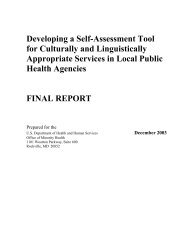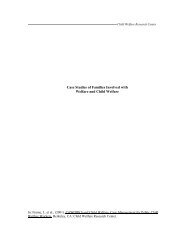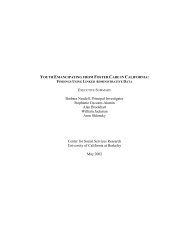Family Assessment in Child Welfare - Center for Social Services ...
Family Assessment in Child Welfare - Center for Social Services ...
Family Assessment in Child Welfare - Center for Social Services ...
You also want an ePaper? Increase the reach of your titles
YUMPU automatically turns print PDFs into web optimized ePapers that Google loves.
<strong>Family</strong> <strong>Assessment</strong> and Measurement CriteriaInterest <strong>in</strong> family relationships began expand<strong>in</strong>g <strong>in</strong> research and cl<strong>in</strong>ical practice with theadvent of systems of child protection <strong>in</strong> the 1970s; however, only <strong>in</strong> recent years have significantef<strong>for</strong>ts been made to develop family assessment <strong>in</strong>struments specifically <strong>for</strong> the child welfarepractice sett<strong>in</strong>g. Three related sets of literatures, stemm<strong>in</strong>g from academic psychology dur<strong>in</strong>g the1970s and 1980s and medic<strong>in</strong>e dur<strong>in</strong>g the 1980s and 1990s, <strong>in</strong><strong>for</strong>m the general topic of familyassessment (Boss, Doherty, LaRossa, Schumm, & Ste<strong>in</strong>metz, 1993). Rooted <strong>in</strong> family systemstheory and family therapy research, a first literature seeks to capture overall family function<strong>in</strong>g,focus<strong>in</strong>g on the family as a primary unit of analysis. Typically, three general with<strong>in</strong>-familydimensions are assessed <strong>in</strong>clud<strong>in</strong>g overall structural and organizational patterns, communicationprocesses, and affective qualities and cohesiveness. For example, the McMaster Model (Epste<strong>in</strong>,Bishop, & Lev<strong>in</strong>, 1978), the Circumplex Model (Olson, 2000), and the Beavers Systems Model(Beavers & Hampson, 2000) represent assessment models <strong>in</strong> this tradition.In<strong>for</strong>med by developmental psychology, a second literature <strong>in</strong>cludes research on theassessment of parent<strong>in</strong>g. This literature identifies relevant components of parent<strong>in</strong>g and typicallyrelates them to child developmental and functional outcomes. In short, it focuses on thecaregiver-child dyad as the key unit of attention. Conceptual and empirical work <strong>in</strong> this areahighlights the follow<strong>in</strong>g five parent<strong>in</strong>g factors that are particularly salient <strong>for</strong> assessment: (1)parent beliefs about the child, (2) perceived efficacy <strong>in</strong> the parent<strong>in</strong>g role, (3) parent<strong>in</strong>g style, (4)parent-child relational qualities, and (5) parent<strong>in</strong>g skills and behaviors. F<strong>in</strong>ally, the stress andcop<strong>in</strong>g literature, as well as related literatures on risk and resilience, <strong>in</strong><strong>for</strong>ms family assessment(see Hill, 1949). For example, McCubb<strong>in</strong> and McCubb<strong>in</strong> (1987) provide a model of familystressors (normative or unexpected; acute or chronic) and the extent to which families managethe stressor without negative effects on the family system. Research identifies two protectivefactors, <strong>in</strong>clud<strong>in</strong>g the <strong>in</strong>ternal and external social support resources of families as well as how thefamily perceives the stressor (i.e., the extent to which the family views the stressor asmanageable). In short, this work places attention on social supports and family appraisalprocesses as a way to understand and assess family function<strong>in</strong>g.These major theoretical and discipl<strong>in</strong>ary <strong>in</strong>fluences have given rise to several practicalissues when consider<strong>in</strong>g the appropriateness of a family assessment measure and method. Whilethere are many approaches, family assessment methods typically fall <strong>in</strong>to three categories: client3
















